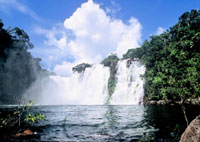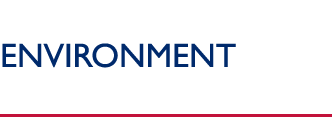
|
Global Climate Change: Adapting to Climate Variability and Change
 At least 20 waterfalls tumble from the edges of the Huanchaca Plateau in Noel Kempff Mercado National Park, Bolivia. The sandstone escarpment rises some 1,800 feet above the surrounding plain. Dennis Fitzpatrick, The Nature Conservancy
Overview
We now know that our climate is changing: this is evident from increases in global average air and ocean temperatures, melting of snow and ice, and rising sea levels. Adaptation refers to efforts to cope with the impacts of current climate variability and future climate change. Rising temperatures, changes in precipitation patterns, shifts in seasons, and rising seas are some of the expected manifestations of climate change. Resulting impacts on water resources, coastal zones, agricultural productivity, and the ranges of diseases could affect both human and ecological systems.
Developing countries are particularly vulnerable to environmental, political, and socio-economic change. Even small disruptions can alter progress toward essential development goals. In economies and societies that heavily depend on natural resources, short and long-term changes in climate can challenge the long-term sustainability of development advances. Resources that must be diverted to recovering from climate-related damages cannot be dedicated to other sustainable development goals.
Development assistance programs need to be resilient to changing climate and environmental conditions to ensure long-term effectiveness. Consideration of changing climate conditions in planning and implementation requires access to information, application of user-friendly tools, and testing and dissemination of tools for development practitioners in the field.
 Waterfall, Usumacinta River, Sierra Lacandón National Park, El Petén, Guatemala. International Resources Group
USAID’s Approach
USAID’s climate change adaptation program seeks to assist Missions and other development partners to build resilience to climate change through a variety of activities. Adapting to climate change requires a hierarchy of linked efforts. We are linking information from observation systems to those lacking such information, improving their understanding of current climate, climate variability and future climate change. We are working to make earth observation information readily applicable to development decisions, including creating innovative applications and appropriate tools to then communicate that information to stakeholders and decision makers. Through interaction with local partners and new tools, we can better understand how environmental changes may impact sectors critical for development. Once those impacts are understood, stakeholders need to assess and agree on preferred adaptation options. Then, on-the-ground actions are implemented to build the resilience of projects designed to promote economic development.
To gather information on the climate, USAID supports activities that seek to improve global climate observations through global, regional, and bilateral observing activities. USAID works with the U.S. National Oceanic and Atmospheric Administration to translate data into useful information by bringing together climate scientists and consumers of climate information at quarterly Climate Outlook Forums in Africa. The forums enable scientists and stakeholders to discuss their information needs and capabilities; the result is a quarterly seasonal forecast that is used by decision makers in such fields as health, food security, and hydropower.
In Central America, USAID and partners support SERVIR, a hub to collect and process climate information, test new and innovative tools, and then apply that information to development problems such as weather prediction, fire monitoring, red tides and disaster response. USAID has recently begun an enhancement effort to be able to apply the SERVIR model to other regions to support climate resilient development.
Climate and weather information can be applied to avoid acute crises. USAID supports early warning systems that integrate seasonal and inter-annual climatic information and local, stakeholder understanding of conditions to forecast potential crises. The most advanced system is the Famine Early Warning System (FEWS-NET), currently operating in 27 countries in Africa, Asia, and South America. FEWS-NET analyzes remotely sensed data and ground-based meteorological, crop, and rangeland observations to track the progress of the rainy seasons in semi-arid regions in order to identify early indications of potential famine. It also works to strengthen capacity, inform decision-makers, and develop policy-relevant information in the regions where it is operating. The FEWS-NET Web site serves as a gateway of information about threats and updates on response measures. Still in their trial stages are a malaria, meningitis, and pest early warning systems.
Related Links
U.S. Government Activities
USAID-supported Activities
Relevant Work of Other Programs
Disclaimer of Endorsement
The pages and documents posted on this Web site may contain links or references to information created and maintained by other public and private organizations, which do not necessarily reflect the views of USAID.
To communicate warnings and other important climate information, USAID works with other organizations to develop innovative communications approaches, such as the solar-powered rural radio network (RANET) in Africa. RANET provides local weather information to remote, solar-powered local radio stations to help farmers and other people to improve their agriculture, silviculture and related economic activities.
Finally, the Global Climate Change team’s adaptation program assists Missions and other development partners to assess and tailor projects to ensure that they function as designed, even as climate changes. To facilitate the process of adapting development projects, USAID has developed a Climate Change Adaptation Guidance Manual to provide planners with the tools they need to understand how climate change may affect their projects. The manual draws on lessons learned in four pilot projects that assessed impacts and vulnerability to climate variability and change, and developed adaptation implementation plans for: urban and coastal flooding in Honduras, municipal water in South Africa, rainfed agriculture in Mali, and fisheries and agriculture in Thailand. These pilot projects and the guidance manual are helping to improve the resilience and sustainability of USAID’s development efforts by integrating climate change adaptation into project planning. The GCC team is available to assist interested Missions adapt their projects to the impacts of climate change.
Conclusion
USAID is engaged in a hierarchy of activities to help developing countries lessen their vulnerability and adapt to climate-related change. These activities are intended to enable Missions, their partners, and the international development community to build more resilience into sectoral activities that may be impacted by climate. The success of these activities can be measured by the degree to which they facilitate the achievement of sectoral objectives in the face of climatic variability and change.
Please note, many links in the Global Climate Change portion of USAID's web sites point to information on the U.S. State Department and White House web sites. Some of these materials may be under review and temporarily unavailable. These links will be updated on USAID's web sites as soon as possible. Thank you for your patience.
Back to Top ^
|




